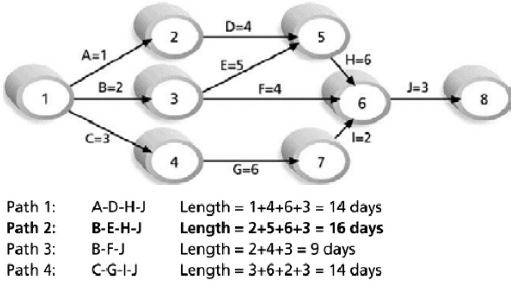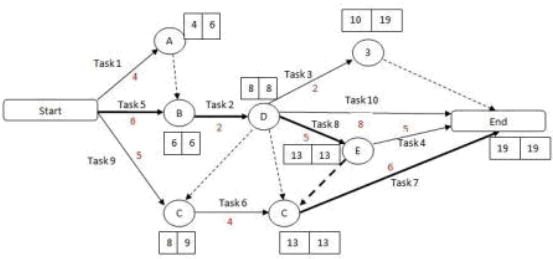The critical path method (CPM) is a way of breaking complex projects into lists of activities, and determining which are critical to keeping a project on schedule. Developed in the 1950s, this method was used for complicated government and private industry programs that were running behind schedule for undetermined reasons. A critical path as defined by the method as a series of events, called activities, which must be completed in the correct order and on time.
Construction or other projects can contain thousands of separate activities that occur before a job is done. Drawings must be made, a construction site must be prepared, and many other events must occur even before construction begins. During construction, foundations and building framework must be completed before the interior work can start. Some activities can occur at the same time, but some must wait until previous activities are completed. All of these assumptions are used in the critical path method.
Calculations of critical path timing can be done manually, but can be quite difficult due to the many interactions of activities. An easier way to create a CPM is using a computer spreadsheet program. Since the late 20th century, commercial software has existed that will create critical path method results from manually entered activity information. CPM is a project network analysis technique used to predict total project duration. A critical path for a project is the series of activities that determines the earliest time by which the project can be completed. The critical path is the longest path through the network diagram and has the least amount of slack or float.
Developing a CPM report requires the use of assumptions, because a project typically has not started when the report is created. A project manager or programmer begins the process by listing all known activities from start to finish. Activities are given constraints if any exist, which may be an earliest calendar date an activity can start, or the latest date one can finish. These date constraints keep activities from moving around in the model, and constrained activities are often part of the critical path.
Along with any fixed calendar constraints, all activities must be given an estimated duration, or the days or weeks needed to finish. An activity may have a long duration, such as putting up building steel or finishing the interior that may cause the critical path to be affected. Software programs available for critical path method modeling will show when an activity has extended past an estimated time. Activity durations can also affect the critical path if they take longer than an estimated project time allows. These results are summarized in the software report when all data have been inserted.
Another function of critical path method software is determining how people are used. Each activity can have a resource, a person or group, assigned to it. An activity normally includes the resource name and how much of their time as a percentage is needed for the activity. Reports can show when a resource is needed more than they are available; for example, employees that are needed for 150% of their allotted time. These constraints allow project managers to shift resources as needed to prevent under- or over-use of personnel during a project.
Complex projects can have cost estimates included in the CPM report. Activities can be listed with an estimated cost to complete and any additional cost if the activity is delayed or extends past the due date. Changes in the critical path resulting in delays or project extensions will have a visible effect on total project cost.
Commercial CPM software is often useful because it can easily show changes in the critical path for real-time activity data. When an activity changes by date or duration, a project manager can input changes into the project schedule and immediately see effects on total project and critical path schedules, resources, and costs. A critical path method will provide the most accurate results by regularly inputting data for a project as it continues, and changing activity dates and durations to actual dates and completion times.
Finding the Critical Path
- First develop an accurate project network diagram
- Add the durations for all activities on each path through the project network diagram
- The longest path is the critical path
Determining the Critical Path

Since the critical path is the longest path through the network diagram, path 2 B-E-H-J, is the critical path for Project X.
Critical path is the sequential activities from start to the end of a project. Although many projects have only one critical path, some projects may have more than one critical path depending on the flow logic used in the project.
If there is a delay in any of the activities under the critical path, there will be a delay of the project deliverables. Most of the times, if such delay is occurred, project acceleration or re-sequencing is done in order to achieve the deadlines.
Critical path method is based on mathematical calculations and it is used for scheduling project activities. This method was first introduced in 1950s as a joint venture between Remington Rand Corporation and DuPont Corporation. The initial critical path method was used for managing plant maintenance projects. Although the original method was developed for construction work, this method can be used for any project where there are interdependent activities.
In the critical path method, the critical activities of a program or a project are identified. These are the activities that have a direct impact on the completion date of the project.

Key Steps in Critical Path Method
Let’s have a look at how critical path method is used in practice. The process of using critical path method in project planning phase has six steps.
Step 1: Activity specification
You can use the Work Breakdown Structure (WBS) to identify the activities involved in the project. This is the main input for the critical path method. In activity specification, only the higher-level activities are selected for critical path method. When detailed activities are used, the critical path method may become too complex to manage and maintain.
Step 2: Activity sequence establishment
In this step, the correct activity sequence is established. For that, you need to ask three questions for each task of your list.
- Which tasks should take place before this task happens.
- Which tasks should be completed at the same time as this task.
- Which tasks should happen immediately after this task.
Step 3: Network diagram
Once the activity sequence is correctly identified, the network diagram can be drawn as shown in figure. Although the early diagrams were drawn on paper, there is a number of computer software, such as Primavera, for this purpose nowadays.
Step 4: Estimates for each activity
This could be a direct input from the WBS based estimation sheet. Most of the companies use 3-point estimation method or COCOMO based (function points based) estimation methods for tasks estimation. You can use such estimation information for this step of the process.
Step 5: Identification of the critical path
For this, you need to determine four parameters of each activity of the network.
- Earliest start time (ES) – The earliest time an activity can start once the previous dependent activities are over.
- Earliest finish time (EF) – ES + activity duration.
- Latest finish time (LF) – The latest time an activity can finish without delaying the project.
- Latest start time (LS) – LF – activity duration.
The float time for an activity is the time between the earliest (ES) and the latest (LS) start time or between the earliest (EF) and latest (LF) finish times. During the float time, an activity can be delayed without delaying the project finish date.
The critical path is the longest path of the network diagram. The activities in the critical path have an effect on the deadline of the project. If an activity of this path is delayed, the project will be delayed. In case if the project management needs to accelerate the project, the times for critical path activities should be reduced.
Step 6: Critical path diagram to show project progresses
Critical path diagram is a live artifact. Therefore, this diagram should be updated with actual values once the task is completed. This gives more realistic figure for the deadline and the project management can know whether they are on track regarding the deliverables.
Advantages of Critical Path Method
Following are advantages of critical path methods.
- Offers a visual representation of the project activities.
- Presents the time to complete the tasks and the overall project.
- Tracking of critical activities.

